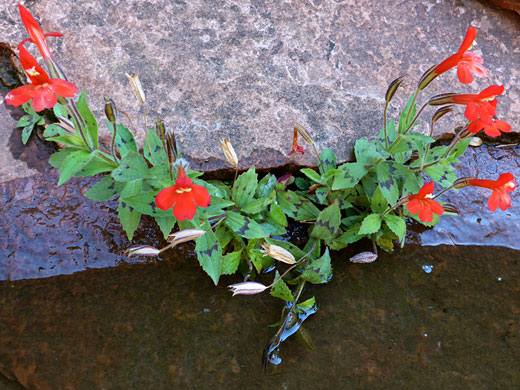Erythranthe Verbenacea, Washington Monkeyflower
Plants > Wildflowers > Phrymaceae > Erythranthe Verbenacea
Common name:
Washington monkeyflower
Family:
Scientific name:
Erythranthe verbenacea
Synonym:
Mimulus cardinalis var verbenaceus
Main flower color:
Range:
Arizona, and far southwest Utah
Height:
Up to 2 feet
Habitat:
Seeps and streambanks in canyons, from 1,000 to 6,000 feet
Leaves:
Cauline, opposite, obovate to elliptic, up to 3 inches long, coarsely toothed, occasionally marked with dark patches
Season:
May to October
Erythranthe verbenacea grows in scattered, riparian locations, in Zion National Park in southwest Utah, and more widely in Arizona, in such places as the Grand Canyon, the canyons around Sedona, and ravines further south, along the edge of the Sonoran Desert. Further northeast the species is replaced by erythranthe eastwoodiae, from which it is distinguished by the upright rather than creeping habit, and the longer pedicels. The permanent water supply allows a long blooming season, late spring to early fall.
The sessile, slightly clasping leaves are lined by coarse teeth, usually only above the middle. Leaves have palmate veins (three or five), radiating from the base. Leaves and stems are sparsely covered by glandular hairs. Leaves for specimens in and around Oak Creek Canyon north of Sedona have leaves crossed by a prominent, dark purple stripe, or blotches, across the middle; leaves for plants in all other locations are unmarked.
Flowers are arranged in an open cluster of between two and 12, at the top of the stem and at the upper leaf nodes. Pedicels are up to 4 inches long at the fruiting stage. The calyx is strongly ridged, and has five short, slightly unequal lobes at the tip. Corollas are bright red, sometimes yellowish-red, around one inch long, with a forwards-pointing upper lip and a three-lobed lower lip, angled at about 90 degrees to the axis. The hairy yellow anthers are exserted, held well beyond the corolla throat.
The sessile, slightly clasping leaves are lined by coarse teeth, usually only above the middle. Leaves have palmate veins (three or five), radiating from the base. Leaves and stems are sparsely covered by glandular hairs. Leaves for specimens in and around Oak Creek Canyon north of Sedona have leaves crossed by a prominent, dark purple stripe, or blotches, across the middle; leaves for plants in all other locations are unmarked.
Flowers are arranged in an open cluster of between two and 12, at the top of the stem and at the upper leaf nodes. Pedicels are up to 4 inches long at the fruiting stage. The calyx is strongly ridged, and has five short, slightly unequal lobes at the tip. Corollas are bright red, sometimes yellowish-red, around one inch long, with a forwards-pointing upper lip and a three-lobed lower lip, angled at about 90 degrees to the axis. The hairy yellow anthers are exserted, held well beyond the corolla throat.
All Contents © Copyright The American Southwest | Comments and Questions | Contribute | Site Map


